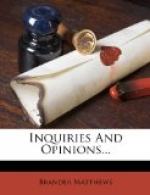I
“The scientific spirit,” so an acute American critic defined it recently in an essay on Carlyle,—who was devoid of it and detested it,—“the scientific spirit signifies poise between hypothesis and verification, between statement and proof, between appearance and reality. It is inspired by the impulse of investigation, tempered with distrust and edged with curiosity. It is at once avid of certainty and skeptical of seeming. It is enthusiastically patient, nobly literal, candid, tolerant, hospitable.” This is the statement of a man of letters, who had found in science “a tonic force” stimulating to all the arts.
By the side of this, it may be well to set also the statement of a man of science. In his address delivered in St. Louis in December, 1903, the President of the American Association for the Advancement of Science,—who is also the president of one of the foremost of American universities,—declared that “the fundamental characteristic of the scientific method is honesty.... The sole object is to learn the truth and to be guided by the truth. Absolute accuracy, absolute fidelity, absolute honesty are the prime conditions of scientific progress.” And then Dr. Remsen went on to make the significant assertion that “the constant use of the scientific method must in the end leave its impress upon him who uses it. A life spent in accord with scientific teaching would be of a high order. It would practically conform to the teachings of the highest type of religion.”
This “use of the scientific method” is as remote as may be from that barren adoption of scientific phrases and that sterile application of scientific formulas, which may be dismissed as an aspect of “science falsely so called.” It is of deeper import also than any mere utilization by art of the discoveries of science, however helpful this may be. The painter has been aided by science to perceive more precisely the effect of the vibrations of light and to analize more sharply the successive stages of animal movement; and the poet also has found his profit in the wider knowledge brought to us by later investigations. Longfellow, for example, drew upon astronomy for the figure with which he once made plain his moral:
Were a star quenched on high,
For ages would its light,
Still travelling downward from the sky,
Shine on our mortal sight.
So, when a great man dies,
For years beyond our ken
The light he leaves behind him lies
Upon the paths of men.
Wordsworth, a hundred years ago, warmly welcomed “the remotest discoveries of the chemist, the botanist and mineralogist,” as “proper objects of the poet’s art,” declaring that “if the time should ever come when what is now called ‘science,’ thus familiarized to men, shall be ready to put on, as it were, a form of flesh and blood, the poet will lend his divine spirit to aid the transfiguration, and will welcome the being thus produced as a dear and genuine inmate of the household of man.”




